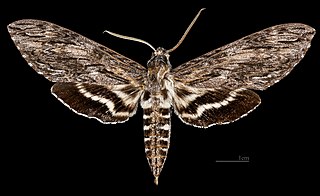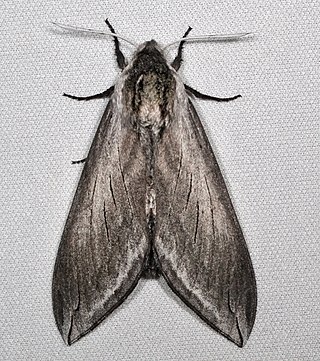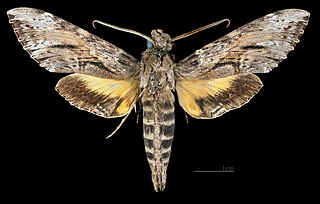
Prunus virginiana, commonly called bitter-berry, chokecherry, Virginia bird cherry, and western chokecherry, is a species of bird cherry native to North America.

Eumorpha pandorus, the Pandora sphinx moth or Pandorus sphinx moth, is a North American moth in the family Sphingidae. The species was first described by Jacob Hübner in 1821.

Sphinx asellus, the asellus sphinx moth, is a moth of the family Sphingidae. The species was first described by Walter Rothschild and Karl Jordan in 1903. It is known from pinyon-juniper woodland and similar arid areas in the US states of Colorado, Nevada, Utah, extreme south-western Wyoming, Arizona, New Mexico and south-western Texas.

Sphinx dollii, or Doll's sphinx moth, is a moth of the family Sphingidae. It is known from arid brushlands and desert foothills from Nevada and southern California east through Utah, Arizona, Colorado, and from New Mexico to Oklahoma and Texas.

Lintneria eremitus, the hermit sphinx, is a moth of the family Sphingidae. The species was first described by Jacob Hübner in 1823. It is found in the temperate areas of the eastern United States, north into southern Canada over the Great Plains. It prefers gardens and yards, but is common wherever the nectar and larval host plants are found. This moth is easily confused with the Canadian sphinx but these two moths do not typically co-occur.

Lintneria eremitoides, the sage sphinx, is a moth from the family Sphingidae. The species was first described by Herman Strecker in 1874. It is known from North America's sandy prairies in the Great Plains from Kansas south through central Oklahoma to Texas, and possibly west to Colorado and New Mexico, and as a rare stray to western Missouri.

Lintneria istar, the Istar sphinx moth, is a moth of the family Sphingidae. The species was first described by Walter Rothschild and Karl Jordan in 1903. It is found in mountains and pine-oak woodlands from southern Arizona east to southern Texas and south through Mexico to Guatemala.

Sphinx libocedrus, the incense cedar sphinx, is a moth of the family Sphingidae. The species was first described by Henry Edwards in 1881. It ranges from the western Texas to southern California and Mexico.

Lintneria lugens is a moth of the family Sphingidae.

Sphinx perelegans, commonly known as the elegant sphinx, is a species of hawkmoth described by Henry Edwards in 1874. It is a large gray moth native to western North America.

Lintneria separatus, the separated sphinx, is a moth of the family Sphingidae. The species was first described by Berthold Neumoegen in 1885. It is found from Colorado south through New Mexico and Arizona to Veracruz and Hidalgo in Mexico.

Sphinx vashti, the Vashti sphinx, is a member of the family Sphingidae of moths. It is found in North America from British Columbia east to Manitoba, south to southern California, Nevada, central Arizona, New Mexico and western Texas.

Isognathus rimosa, the rimosus sphinx, is a moth of the family Sphingidae. The species was first described by Augustus Radcliffe Grote in 1865.

Eumorpha typhon, the Typhon sphinx, is a moth of the family Sphingidae. The species was first described by Johann Christoph Friedrich Klug in 1836.

Sphingini is a tribe of moths of the family Sphingidae. The tribe was described by Pierre André Latreille in 1802.

Lintneria is a genus of moths in the family Sphingidae, containing the following species:

Callionima parce, the parce sphinx moth, is a species of moth in the family Sphingidae.It was originally described by Johan Christian Fabricius in 1775.
Lintneria pitzahuac is a moth of the family Sphingidae. It is known to be from Mexico.

















